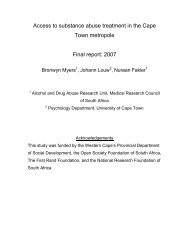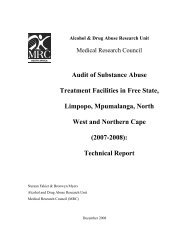Pan-African Conference 21 - 24 July 2002 Inter-Continental Hotel ...
Pan-African Conference 21 - 24 July 2002 Inter-Continental Hotel ...
Pan-African Conference 21 - 24 July 2002 Inter-Continental Hotel ...
You also want an ePaper? Increase the reach of your titles
YUMPU automatically turns print PDFs into web optimized ePapers that Google loves.
Abstracts 10/22/02 11:26 AM Page 13<br />
The role of FAO in information technology for the advancement of nutrition<br />
/ Le rôle de la FAO en TI et le développement de la nutrition<br />
Tanja Wildemann, FAO, Rome, Italy; DG Gustafson, FAO, Nairobi, Kenya<br />
As a consequence of major changes in information technology in the 1990s,<br />
computers found their ways into all areas, including food and nutrition. The<br />
overwhelming amount of information especially in the internet makes it<br />
necessary to establish a sophisticated information management system.<br />
The implementation of the World Agricultural Information Centre (WAICENT)<br />
was an important step to fight hunger with information. This portal provides<br />
access to a large amount of information resources, including documents,<br />
statistics, maps and multimedia resources and to capacity building<br />
programmes in information management. WAICENT assists with its<br />
knowledge and experience all other departments in the development of their<br />
numerous projects concerning food security, food safety and human nutrition.<br />
Food Security:<br />
The Food insecurity and vulnerability information and mapping systems (FIVIMS)<br />
are networks of systems, that collect, analyse and disseminate information<br />
about food insecurity and vulnerability. Additional systems contribute to the<br />
effectiveness of FIVIMS: The software Key Indicators Mapping System (KIMS)<br />
facilitates the management of the collected data, the Key Indicators Database<br />
System (KIDS) provides internationally comparable data and the Global<br />
Information and Early Warning System on Food and Agriculture (GIEWS) gives<br />
further information to foresee and intervene in time in emergency situations.<br />
Food Safety:<br />
The Codex Alimentarius Commission (CAC), which was established in the early<br />
1960s by FAO and the World Health Organization (WHO), dedicates its work<br />
the protection of consumer health and fair practices in food trade.<br />
The Joint FAO/WHO Expert Consultations assess the risks related to<br />
microbiological hazards, biotechnology and food additives and contaminants.<br />
The findings contribute directly to the work of the CAC by providing the<br />
scientific basis.<br />
Human Nutrition:<br />
The Nutrition Country Profiles cover numerous countries and give general<br />
information about the country and its population as well as specific data about<br />
the food and nutrition situation, which statistical databases are<br />
complementing.<br />
The regularly publishing of the on-line journal “Food, Nutrition and<br />
Agriculture” gives a short and good overview of the efforts made in<br />
community nutrition, food quality and safety, food security, etc.<br />
The recent project “Feeding minds, fighting hunger” takes advantage of the<br />
increasing availability of the internet in the whole world to disseminate a<br />
variety of data. This information provides educators with teaching material to<br />
introduce their students to the topics of malnutrition and hunger.<br />
FAO’s efforts, to make this large amount of information easy accessible<br />
through the internet, aim at the assistance and provision of governments with<br />
relevant, latest and necessary information for the formulation of agricultural<br />
policy and planning in order to improve the well being and standard of living<br />
of the population. Other information contribute to the correct estimation of the<br />
food and nutrition situation and to a fast and timely intervention in emergency<br />
situations. FAO and non-governmental and civil society organizations are<br />
cooperating in areas of common interests, e.g. the condition of rural<br />
populations and production and distribution of agricultural products.<br />
Computer-based tools for educating health professionals about nutrition /<br />
Produire du matériel pédagogique interactif<br />
Steven H. Zeisel, MD, PhD<br />
McGavran-Greenberg Building, University of North Carolina, Chapel Hill,<br />
NC, USA<br />
In this lecture, we will describe how we approached the development of the<br />
successful Nutrition in Medicine CD-ROM series that is currently in use at<br />
more than 125 medical schools throughout the world. We developed, with<br />
funding assistance from the NIH and industry, a series that eventually will<br />
consist of 10 CD-ROMs (The Disease Series (Nutritional Anemias, Nutrition<br />
and Stress, Nutrition and Cancer, Diet, Obesity and Cardiovascular Disease,<br />
and Diabetes and Weight Management: Aberrations in Glucose Metabolism);<br />
the Lifecycle Series (Maternal and Infant Nutrition, Nutrition and Growth,<br />
and Nutrition for the Second Half of Life*); and the Special Topics In Nutrition<br />
Series (Nutrition Supplements and Fortified Foods*, and Sports Nutrition;<br />
ABSTRACTS<br />
those with asterisks are currently under development). Our unique approach<br />
is to immerse the user in a virtual experience that brings our information to<br />
life, we call this edutainment. Our CDs use sophisticated graphics,<br />
animations, audio and video to present an experience that makes nutrition<br />
come to life. Users enter a patient’s life and see what goes on in the doctor’s<br />
office. Rather than using a traditional structure (i.e., lectures on vitamins,<br />
minerals, lipids, protein, etc.), in each program a number of issues derived<br />
from the simulated patient’s problems are used to teach the principles of<br />
nutrition and to illustrate the interaction between nutrition and health or<br />
disease. Nutrition science is presented in a manner that makes it easy for other<br />
medical disciplines to see how this science relates intimately with their special<br />
interests. Practical clinical exercises (problem sets) that differ from the<br />
simulated patient presented in the video promote the actual use of the<br />
acquired knowledge and test the necessary skills. A formal board exam is<br />
available at the end of the program. These exercises and exams provide a<br />
convenient means for additional strengthening of the student’s knowledge<br />
base. These performance data are available to the instructors and can be used<br />
for student evaluation.<br />
The Nutrition in Medicine have the following minimum system requirements:<br />
Pentium CPU/90 MHz with 16 MB RAM; Windows 95 or NT; 4x (or greater)<br />
CD-ROM drive; Monitor capable of 640x480 resolution running thousands of<br />
colors. QuickTime and Acrobat Reader must be installed onto the hard drive,<br />
are included on the CD.<br />
S13

















